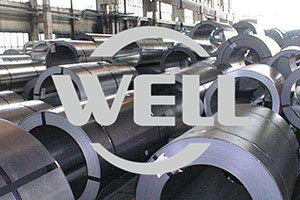In 2018, the domestic steel supply will increase slightly while the export of steel products may increase
Date:2018-01-12 03:53:18 Visit:1864
Customs data show that in the first 11 months of 2017, China's steel exports totaled 69.83 million tons, down 30.7% from the same period of last year. This figure shows only the direct export of Chinese steel, despite the large drop in exports. Taking into account the indirect export volume of steel, China's steel exports can still achieve overall stability in 2017. "A lot of steel is exported in the form of terminal products in the form of automobiles, appliances, ships and other commodities." Industry analysts believe that this part of the increase in steel consumption is almost equivalent to the reduction of direct exports of steel in our country.
Earlier analysis of the industry pointed out that the full year 2017, China's steel exports or 75 million tons, down 35 million tons year on year. The first two years, China's steel bar and flat steel exports almost equal shares. In 2017, the proportion of plate exports in China rose to about 55%.
Supply-side structural reform to improve the operating conditions of the steel industry improved. In 2017, the average steel price index was at 3952 yuan / ton, at a relatively high historical level. However, Wang Jianhua believes that the current policy effect has not been fully released. As long as the policy of supply-side structural reform will not waver in 2018, the determination of enterprises to improve the quality and efficiency will not change. Under the inertia of the market, steel prices will still have room for growth of 5% -10%.
From the perspective of global supply and demand, in 2017, while the steel exports in China are decreasing, the output of crude steel in other main producing areas of the world is obviously increased. However, excluding the apparent consumption in other countries except China, the actual consumption of crude steel did not increase substantially or slightly. Ren Zhuqian accordingly judge, in 2017 China's steel exports are not driven by external demand, and more is based on the spread changes. In 2018, with the increase of crude steel output in China, if the domestic downstream demand remains flat, the export volume is bound to increase to ease the supply pressure in the domestic market.
In 2018 exports are much better
Analysts expect that if the production season is limited and the environmental protection pressure is normalized, the output of crude steel in China will increase by about 25 million tons in 2018, and the products will mainly be mainly building materials. In the context of the overall increase in output, steel exports will show what kind of trend?
Judging the import and export situation, "BDI" is a very important macro-leading indicator. After the BDI hit a stage bottom in late 2015, BDI has fluctuated upward in the past two years and the manufacturing managers' index in the United States and Europe has been above 50, all of which indicate that the global economic recovery is continuing. Analysts believe that the U.S. tax cuts and extensive infrastructure construction will stack up the steady growth of China's economy and the global economy will maintain a sustained recovery in 2018. At the same time, we must note that the global economy is in the early stages of the "Juglal cycle," which will bring about impetus to the export of machinery and transportation equipment in our country and will lead to the indirect export of steel products. The latest tariff adjustment is also good steel exports. Under the multi-factor promotion, the direct export of steel in our country will increase slightly or steadily in 2018, and the direct or indirect export of steel will increase by more than 15 million tons.
Judging from the domestic market, in 2018, manufacturing development, infrastructure construction and consumer demand will bring steady demand for steel. The real estate market demand may be the only area where reduction is possible. Overall, the domestic supply of steel will increase slightly in 2018, demand may stabilize slightly, and the entire supply and demand side will maintain a relative balance. This will also be good for exports.
In 2018, the prices of raw materials may drop slightly, and the stocks of raw materials such as iron ore, coke and other raw materials will further increase on the basis of 2017. The contradiction between supply and demand in the market will be eased, shifting from the tight balance to the modest partial loose. Steel exports will grow marginally, and profitability of manufacturing enterprises will return to normal.
At present, the growth rate of fixed asset investment in the entire black metallurgical industry has been negatively increasing year after year. The adjustment of product structure in the future steel industry will be the general trend. The steel production capacity will change from the total amount to the structural adjustment stage. Green, energy saving and soundness are the main themes of the industry's development. The main contradiction in the steel industry has been transformed to produce the products that the market needs to reduce ineffective output.
In 2017, China's steel industry went over capacity to meet its requirements, but the structural contradictions in the industry are still outstanding. In 2018, steel production and demand will be generally stable. Steady operation of steel market should pay attention to grasping the pace of production. Reasonable return of steel prices and reasonable price operation are reasonable guarantees for the smooth operation of steel enterprises. At the same time, the price of imported iron ore has a great relationship with the benefit of steel mills. It is necessary to strengthen the coordination between mines and steel mills and speed up the transformation and upgrading of steel mills.

Earlier analysis of the industry pointed out that the full year 2017, China's steel exports or 75 million tons, down 35 million tons year on year. The first two years, China's steel bar and flat steel exports almost equal shares. In 2017, the proportion of plate exports in China rose to about 55%.
Supply-side structural reform to improve the operating conditions of the steel industry improved. In 2017, the average steel price index was at 3952 yuan / ton, at a relatively high historical level. However, Wang Jianhua believes that the current policy effect has not been fully released. As long as the policy of supply-side structural reform will not waver in 2018, the determination of enterprises to improve the quality and efficiency will not change. Under the inertia of the market, steel prices will still have room for growth of 5% -10%.
From the perspective of global supply and demand, in 2017, while the steel exports in China are decreasing, the output of crude steel in other main producing areas of the world is obviously increased. However, excluding the apparent consumption in other countries except China, the actual consumption of crude steel did not increase substantially or slightly. Ren Zhuqian accordingly judge, in 2017 China's steel exports are not driven by external demand, and more is based on the spread changes. In 2018, with the increase of crude steel output in China, if the domestic downstream demand remains flat, the export volume is bound to increase to ease the supply pressure in the domestic market.
In 2018 exports are much better
Analysts expect that if the production season is limited and the environmental protection pressure is normalized, the output of crude steel in China will increase by about 25 million tons in 2018, and the products will mainly be mainly building materials. In the context of the overall increase in output, steel exports will show what kind of trend?
Judging the import and export situation, "BDI" is a very important macro-leading indicator. After the BDI hit a stage bottom in late 2015, BDI has fluctuated upward in the past two years and the manufacturing managers' index in the United States and Europe has been above 50, all of which indicate that the global economic recovery is continuing. Analysts believe that the U.S. tax cuts and extensive infrastructure construction will stack up the steady growth of China's economy and the global economy will maintain a sustained recovery in 2018. At the same time, we must note that the global economy is in the early stages of the "Juglal cycle," which will bring about impetus to the export of machinery and transportation equipment in our country and will lead to the indirect export of steel products. The latest tariff adjustment is also good steel exports. Under the multi-factor promotion, the direct export of steel in our country will increase slightly or steadily in 2018, and the direct or indirect export of steel will increase by more than 15 million tons.
Judging from the domestic market, in 2018, manufacturing development, infrastructure construction and consumer demand will bring steady demand for steel. The real estate market demand may be the only area where reduction is possible. Overall, the domestic supply of steel will increase slightly in 2018, demand may stabilize slightly, and the entire supply and demand side will maintain a relative balance. This will also be good for exports.
In 2018, the prices of raw materials may drop slightly, and the stocks of raw materials such as iron ore, coke and other raw materials will further increase on the basis of 2017. The contradiction between supply and demand in the market will be eased, shifting from the tight balance to the modest partial loose. Steel exports will grow marginally, and profitability of manufacturing enterprises will return to normal.
At present, the growth rate of fixed asset investment in the entire black metallurgical industry has been negatively increasing year after year. The adjustment of product structure in the future steel industry will be the general trend. The steel production capacity will change from the total amount to the structural adjustment stage. Green, energy saving and soundness are the main themes of the industry's development. The main contradiction in the steel industry has been transformed to produce the products that the market needs to reduce ineffective output.
In 2017, China's steel industry went over capacity to meet its requirements, but the structural contradictions in the industry are still outstanding. In 2018, steel production and demand will be generally stable. Steady operation of steel market should pay attention to grasping the pace of production. Reasonable return of steel prices and reasonable price operation are reasonable guarantees for the smooth operation of steel enterprises. At the same time, the price of imported iron ore has a great relationship with the benefit of steel mills. It is necessary to strengthen the coordination between mines and steel mills and speed up the transformation and upgrading of steel mills.






